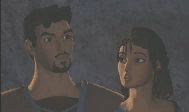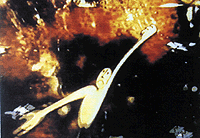Jayanti Sen finishes up her profile of animation in India by profiling the current projects, companies and artists that are helping to build India into an animation nation of force.
Part III

Watch the trailer for Sinbad, The Veil of the Mists. © Pentafour.
Ishu Patel Makes Waves Outside India
As Indian animators like Ram Mohan and Bhimsain were gradually making their presence felt in world animation, a quiet village boy from Gujrat went out to join the National Film Board of Canada and stun the world -- Ishu Patel. From an unschooled village boy whose first canvases were mud walls and first pens just pieces of chalk, Ishu became an excellent graphic designer trained at the National Institute of Design (NID), and then with the help of a Ford Foundation Scholarship he was sent to Switzerland for higher studies in Graphic Design by NID. On his return he taught at NID for a short stint but was already working on animated films. Thus a Rockefellar Foundation Scholarship enabled him to join the National Film Board of Canada.
At the NFB, Ishu Patel made more than fifteen films like Paradise, The Bead Game, Island and more. In his animation, Ishu brings a pronounced touch of the surrealistic, delving into the depths of the human psyche. His films tell us that at a certain point, animation should be "felt," rather than just seen. Immediately following his father's death, Ishu made a film, Afterlife, where we feel the traumatic state of his mind through a strong series of stylized graphic images. At NID Ishu made one film using cut-out animation, and his total control over animation, movement and his sensitivity to music is very clear in this film. Today Ishu Patel is a name to reckon with and in the international arena he presents India's capability very well. He has now left active filmmaking to teach animation at the University of Southern California.
Manick Sorcar -- A Silent Magician At Work
With magic in his blood and growing up in an atmosphere that was seeped in wizardry of all sorts of magicians, young and old, it was no wonder when an electrical engineer chose another form of magic -- the willing suspension of disbelief in the form of animation filmmaking. For Manick Sorcar is the eldest son of the world-famous magician, P.C. Sorcar.
When his own work as an engineer lead him to settle in the United States, in the city of Denver, Colorado, Manick decided to stay. But remaining away from home and hearth could not take him away from his own personal and cultural roots in India. But because he was seeing a lot of animation all around him, he decided to take a different path -- that of combining live-action and animation. Thus Deepa And Rupa: A Fairytale From India came into being. The story of two sisters, one good and the other evil, explains how each of them receive the results of their conduct from the reigning deity of the moon. The film was very well received at several international children's programmes. Children lapped up the film with its exciting storyline and the sheer fun of seeing live-action characters interacting with animation characters. The film was even screened at various schools in the States, and the result was overwhelming.
This enthusiastic response led Manick to embark on a far more ambitious project: The Woodcutter's Daughter. Since he is taking all his stories from Indian roots, Manick Sorcar and family, a lot of who are connected with the filmmaking process as actresses. Apart from promoting the cause of Indian animation in general, they are also the cultural ambassadors from an Indian point-of-view. For this Manick and his team should be highly applauded.
The Woodcutter's Daughter has a lovely storyline about a squirrel who is adopted by a poor woodcutter and turned into a human baby by a fish with magical powers. The story holds a final surprise for us; it is all about how and whom the beautiful squirrel-turned-woman chooses for a husband. Manick enjoys playing with colours, and toying around with movement, so this endears him even further to his young audience.
The amount of time and energy that goes into the making of his films is simply amazing and he and his team deserve full credit for that. But as he sees his work, one thing becomes very clear, Manick needs far more exposure to the animation community both for his own benefit and theirs. The world should know about this quiet magician. To be more successful as an animator, Manick, must be in active touch with the community for his own refinement. But even without that, this animator from the Eastern Region has made an impact outside of India, and he should be congratulated. His other films include Sniff and The Sage and The Mouse, both of which were also big hits. Keep working, Manick! India needs people like you to establish itself in global animation arena.

Sinbad is a bright spot for Indias entrance into the global animation scene. © Pentafour.
Pentafour's Sinbad -- A New Revelation In Animation
With the release of Sinbad: Beyond The Veil Of Mists, Indian animation will touch new heights of achievement. Using the age-old stories of the Arabian Nights a totally different kind of film was created. The character designs and background layouts are completely computer generated, and directors Evan C. Ricks and Alan Jacobs have done wonders. The most important aspect of the film, which catches our eye as animators, is the quality of movement. The elegant flow of motion that has been achieved makes one think this is a cel animation film. As we move through the films promo, the first thing thatwe remember is Disney's The Lion King. But where The Lion King used a "real world" pace, Sinbad uses a much more stylized flow, reminiscent of Lotte Reiniger or Joan and Peter Földes, the computer-aided animation pioneers.
From its opening sequence, the audience is left spellbound. Spectacularand gigantic, yet intensely beautiful colours flow across the screen, and an excellent soundtrack contributes to an effect that is greatcinema. Motion-capture technology is used and exploited to the fullest.The computer technology reaches and opens a new horizon for Indian animation to the world at large. Due for international release soon, let us wait with a lot of suspense and anticipation to see the whole feature.

Ram Mohan teamed with Derek Lamb to make Meena, Its Got to be a Boy for UNICEF. Courtesy of Janyanti Sen. © UNICEF.
Of Animation, Ram Mohan And Indian Cinema
Today Indian animation has become almost synonymous with a fewnames. One is set aside due to the fact that he was chosen by two all time greats of Indian cinema, Satyajit Ray and Mrinal Sen, to create pieces of their films using animation. A lot has been written about his contribution to animation but this is one part of his career and achievements about which Ram Mohan has never spoken. After his stint at the Government Films Division, Ram Mohan went on to join the Prasad Film Laboratories where along with Suresh S. Naik, Satam, Praful and others, he worked for ten years. In 1979, he opened his own studio Ram Mohan Biographics. During his time at Prasad, he createda highly intriguing film using cut-out animation called Harmony,whose elegance in movement can be compared only to that of Lotte Reiniger. His association with Yugo Sako to create Ramayana is also verywell known. But when we come to his association with Ray and Mrinal Sen, let us get it from his own pen. Regarding Mrinal Sen's BhuvanShome he says, "It was the first Indian feature film for whichwe animated some footage that was an integral part of the story (asopposed to animated credit titles for some Hindi comedy features). Mrinalda gave me a free hand at designing the sequence. The idea wasto create the ambience of a beaurocrats work place, with his swivel chair, a large table laden with files that moved from the 'in' tray to the 'out' tray. Shome's presence was suggested by a smolderingcigar." This was done in 1969 and according to Mrinal Sen by using conventional paper cut-outs. The other animated sequence is when Shomedreams of going duck hunting, and has a ring of quacking ducks, circlinground Utpal Dutt's head. The animation used the combined efforts of the director and animator to create the feeling of deep loneliness, which every human being at some point has to face and must come toface in order to have a better understanding of the person within.
Another of Ram Mohan's important projects was with Satyajit Ray's film Shatranj Ke Khiladi. According to Ram Mohan, "The film opens with an introductory sequence that explains the political situationin Wajid Ali Shah's Oudh, and Dalhousies' plans to annex certain stateswhich he saw as cherries ripe for the plucking. The animated scenes were essentially political cartoons and Ray was very clear about how he wanted these visualized. He suggested the company drawingsstyle for the character designs and the limited, staccato movements of the cut-out animation inserts one saw in Monty Python shows. It was a great pleasure working with Ray who is one of the few filmmakersI have met who could communicate his concepts with such clarity and precision." This is perhaps the best capsule of what constitutes thebasic elements of animation use in Ram Mohan's involvement with Satyajit Ray.
Animation Studios - Big And Small
India boasts many animation studios -- big and small. In Bombay,in addition to Mohans RM-USL,which has bagged several foreign animation orders including Disney Televisions 101 Dalmatians, studios are doing importantwork. These include Crest Communications, CMM Studios and Silver Toons in Bombay, plus some other small studios run by animators who learnt their craft at Ram Mohan Biographics. Thus Ram Mohan has played a big role in creating a majority of the young animators who are now operating as smaller studios. Outside of Bombay we have in Madras Pentafour, Motion Graphics and Zica. Zica is also a training institute producing student films like The Lift, which won the best animationaward at the International Children's Film Festival in Hyderabad.

Disney has sent some of their production to India like the TV series 101 Dalmatians. © Disney. All Rights Reserved.
When we look at the current state of Indian animation where the studios are concerned we have every reason to feel happy. Another important animation centre is blossoming in Hyderabad where Heart Animationis a training institute cum supplier of foreign animation studio orders. The studio is working on many assignments from outside of India. Crest Communications is right now working on an 80-minute animation feature co-produced with Hollywood's Rich Animation. Another live-action/animation feature film is going to start soon at Crest Communications. They are working on a virtual reality project for a film for BelgiumsVertek. Another studio operating in Delhi called Span India Communications is also working on virtual reality projects and caters mostly to the overseas market. Unfortunately, Pictoreel Facet and Gimmicks in Bombay are now closed down, but Bhimsains Climb Films, his son KireetKhuranas 2NZ Studios and the oldest studio in Bombay Suresh Naik's Cine Magic are working double-time supplying title animations, special effects and opticals for the feature film industry and, ofcourse, commercials. All of these studios thrive on commercials. Naturally, these arent all of the companies in India, but we can say thatat least in Bombay, Madras and Hyderabad a robust animation industry has grown up. Only the Eastern Region, with its infantile animation, is still reeling from a lack of funding, proper animation awareness and training facilities. Still the present generation of animators is trying to fill this vacuum and only the future can say what can and cant be achieved. Letus hope for the best.
Indian Animation Becomes Commercial -- The Animation Ad Comes Alive
We saw earlier that at the very beginning, animators like Mandar Mullick had the vision to realize animations potential as a very strong weapon in the advertising field. Maybe his own contact and correspondence with Walt Disney, which our now world famous painter Ganesh Pyne, an animator then, saw in Mullicks studio, helped him to develop the idea. However the animation ad industry really flourished in the hands of Ram Mohan and Bhimsain. In the early Sixties we saw a massive boom in the ad industry as a whole, especially in Bombay, or Mumbai as it is now called. India's growth in the industrial sector with more and more multi-national companies like Coca-Cola spreading their wings had a direct effect on the growth of the animation advertisement industry.
But even in the initial stages, the animation ad was playing a different game altogether when compared to its counterpart the mainstream animated film. To maintain the extreme commercial smartness of ads in general, they are given a huge budget. As Ram Mohan stated to me, the ad industry gives huge budgets to commercials in order to maintain the high standard of sale ability and reach a massive audience.

Bhimsains The Fire. Courtesy of Jayanti Sen. © Bhimsain.
To achieve this high standard, the animation studios and individual animators must work very hard and it is through these commercials that the real capability of the animator is realized. Here they finally get enough funding to create the kind of film they want to make. Even within the constraint of just 20 seconds, creativity faces a challenge, which must be met as today most animators depend on ads to provide their main source of support. In the Sixties, Ram Mohan was making a lot of these ad spots, and so was Bhimsain. One especially remembers an ad for a refrigerator, where a penguin with all of its Arctic associations was very intelligently used. The result was highly innovative and interesting. As the sport of cricket gained an all-encompassing popularity, a certain brand of pencil used not only in cricket but also in cel animation in its promotions. Another kind of animation, which is normally never used in mainstream animation, is product animation. However, ad spot makers just lapped it up to promote brand-products like biscuits, soap, detergents -- all brought to life using computer-aided 2D or 3D animation.
Today a lot of these ads are using computer-aided animation to save on time. Studios in Mumbai like Crest Communications, CMM, Climb Films, 2NZ and others are all creating a massive amount of such ad spots. Although all of these studios and individuals were approached to get a clear picture of commercial animation, strangely enough, only Suddhasttwa Basu of Raikhik Films and Kireet Khurana of 2NZ responded. So we must restrict a more detailed analysis to these two filmmakers only.

Trade by Kireet Khurana. Courtesy of Jayanti Sen. © Kireet Khurana.
When we study the works of these two filmmakers, we see that they are working in two different styles altogether. Kireet follows a simple narrative pattern in his work. For instance, an ad for a detergent shows a lot of hanging shirts coming to life and talking to one another about their brightness. On the other hand, in Basu's work one feels the presence of a painter. Although he has to work according to the needs of the client, the artist within him shows through in the jazzy brilliance of the colour scheme, the elegance of the colour-movement and the total quality of the film. Both Kireet and Basu are ad-filmmakers who can churn out films of the highest international standard. Kireet opens his demo-show reel with an extremely interesting piece of animation where we see papers flying out from a light table to become live drawings. Both Basu and Kireet's ad-spots bring out one home-truth -- given the required money and opportunity, India has all the talent necessary to create animation for the international market. A special trait of Basu is his use of character animation. He is a specialist in creating interesting animation characters that he uses in his ads. On the other hand, Kireet is as sleek as Basu but for him he is most comfortable utilizing the computer, with which he creates extremely interesting ads using product animation or 3-D images.
We are seeing more and more animation ads and they work very well on the audience. But strangely, it is these same sponsors who do not give us the minimum necessary budget for creating animation based on fiction or other subjects. Until and unless this basic dialectics of the system are sorted out, Indian animation's future will remain a bit uncertain. Nevertheless, the future of commercials looks bright. Lets wish it continued success.
Future Of Animation In India
Today, as awareness of animation seems to be growing, the picture of Indian animation definitely looks promising. With so many young animators at work, and new studios like Toonz Animation India opening up, we can hope that Indian animation will at last be very much a part of the world animation scene. There are many bright spots like Sinbad, Hanuman and the healthy commercial market, but we need sponsors to realize that animation as an industry demands no less attention than sports or other forms of entertainment. Established animators should try and activate the Indian government to train junior animators particularly in the Eastern Region and far-off Northeast. A lack of a proper training faculty is giving rise to numerous studios boasting animators who do not have proper training. They claim graphic design is not required in their software packages. This is a disturbing trend and it is high time that Indias government sets up animation training centres where a proper and complete animation curriculum is taught using government funding. These centres could even cater to government needs like creating animation for training groups like the army or navy, or even science museums, where instructional films could be used. Our senior animators who have international standing must work harder to create animation awareness throughout India and seek greater government help. Lack of proper equipment is another problem that they must think about. The opening of a new studio like Toonz Animation India is good news, but it remains to be seen how much this company can contribute to the total animation scene in India. Moreover, with foreign funding helping these big studios, Indian animation has a lot to expect from them.

Sinbad could create a new kingdom for Indian animation in U.S. theatres. © Pentafour.
According to Abhijit Dasgupta, the producer of Calcutta TV's first animation series, "For animation's own market, the sky is the limit." This is a true statement for all of us, the Indian animators, whose aspirations are to reach to the sky and leave our own imprints for the future. As we are entering a new century, Indian animation is spreading its wings to fly and explore new ways of expression and ideas, to give a different shape to Indian cinema as a whole.
Get the entire picture, read parts I and of "India's Expanding Horizons" by Jayanti Sen in Animation World Magazine.
Jayanti Sen has been working as a freelance journalist for various English and Bengali journals in India and abroad for the last seventeen years writing on subjects such as cinema, theatre, art, music, science, puppetry, advertising and animation. She is also an animation filmmaker who has had several of her films screened in International film festivals.







